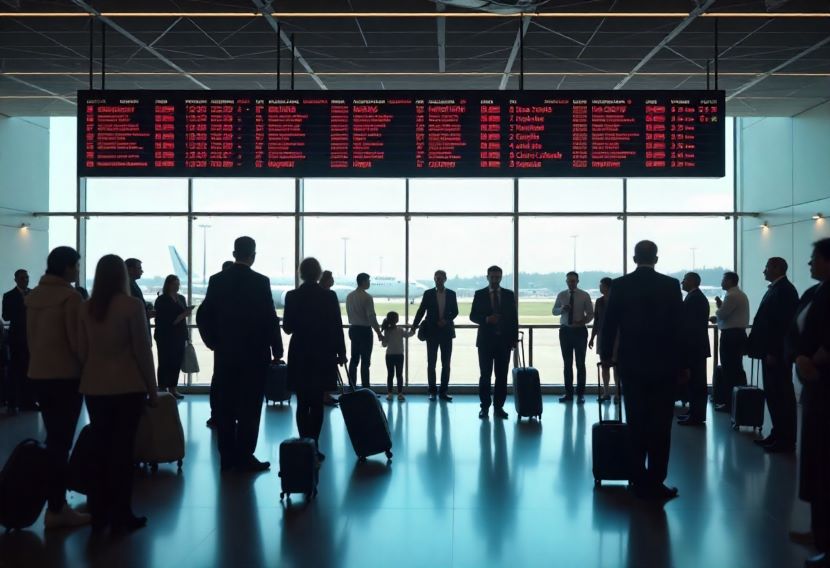A cascade of technical failures plunged major UK airports into widespread chaos recently, disrupting the meticulously planned summer journeys of countless travelers and casting a long shadow over the nation’s vital air travel infrastructure. What began as an ordinary busy travel day swiftly devolved into a logistical nightmare, trapping thousands of holidaymakers and business travelers in a web of sudden cancellations and prolonged delays across the country.
The root of this extensive disruption was traced back to a critical radar fault within the National Air Traffic Services (NATS) control centre in Swanwick. Official government reports confirm that the primary radar system experienced a temporary malfunction, necessitating the immediate suspension of all outbound flights. Although backup systems were promptly activated within twenty minutes, this brief but crucial outage triggered a complex chain reaction, affecting air traffic operations for several hours thereafter and creating a backlog that rippled through the entire UK aviation network.
The impact was staggering, with more than 120 flights either severely delayed or cancelled outright. Key aviation hubs, including Heathrow, Gatwick, Edinburgh, Manchester, Birmingham, Cardiff, and London City airports, bore the brunt of these disruptions. Passengers recounted scenes of utter confusion, navigating lengthy queues and grappling with a profound lack of clarity regarding rescheduled departures or viable alternative travel arrangements, exacerbating their already stressful predicaments.
Airlines were quick to voice their profound dissatisfaction with NATS over the incident. Ryanair’s Chief Operating Officer, Neal McMahon, publicly condemned the technical failure and vehemently called for accountability, notably demanding the resignation of NATS CEO Martin Rolfe. Similarly, EasyJet’s Chief Operating Officer, David Morgan, expressed strong disappointment, emphasizing the unfortunate timing of the disruption during the peak summer travel season, which compounded the inconvenience for thousands of passengers nationwide.
Beyond the operational turmoil, the human cost of these airport delays UK was palpable, as thousands of travelers expressed immense frustration over missed personal and professional commitments. Social media platforms became a poignant forum for accounts of passengers stranded overnight, detailing how they missed significant family events such as weddings and reunions, alongside crucial business meetings. The emotional toll on travelers was further intensified by pervasive uncertainty and the noticeable lack of immediate, clear communication from both airlines and airport authorities, adding to the air travel chaos.
The widespread radar glitch significantly impacted both the tourism and broader business sectors across the UK. Business travelers faced substantial setbacks to critical meetings and incurred increased operational expenses due to unforeseen flight changes and last-minute rebookings. Concurrently, local tourism businesses, encompassing hotels, restaurants, and entertainment venues, reported an unexpected downturn in expected arrivals, directly affecting their revenue during what is typically one of the busiest and most profitable periods of the year for summer travel disruption.
In response to the crisis, UK Transport Secretary Heidi Alexander sought to reassure the public through official government channels, confirming that authorities were diligently monitoring developments. Travelers were strongly advised to remain updated by continuously checking airline websites and official airport announcements. Authorities underscored the importance of understanding passenger rights as outlined by the Civil Aviation Authority (CAA), actively encouraging affected individuals to pursue due compensation where applicable for the widespread UK aviation disruption.
This incident, however, is not an isolated event but rather indicative of a troubling pattern observed within UK air traffic control systems over the past two years. A similar, significant disruption in August 2023 had previously stranded thousands of passengers and ignited widespread criticism. These repeated issues have intensified scrutiny on the reliability and infrastructure robustness of NATS operations, raising critical questions about their preparedness for future challenges in the perpetually growing air travel demand.
Consequently, industry experts and leading aviation authorities are strongly advocating for substantial increased investment into advanced air traffic management systems. The growing frequency of technical disruptions unmistakably highlights inherent vulnerabilities in the current infrastructure, underscoring the urgent need for updated technology and greatly improved resilience strategies. Reinforcing this technological foundation is deemed critical to maintaining passenger trust, especially as air travel demand continues its robust surge post-pandemic, ensuring both safety and efficiency for all future UK aviation endeavors.






Leave a Reply